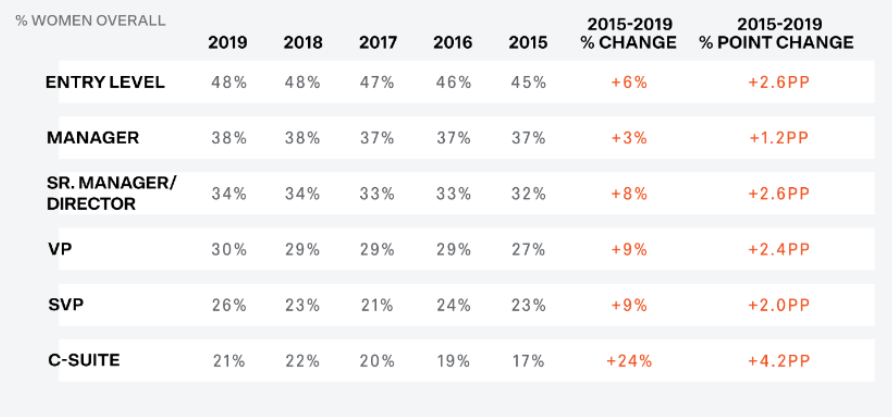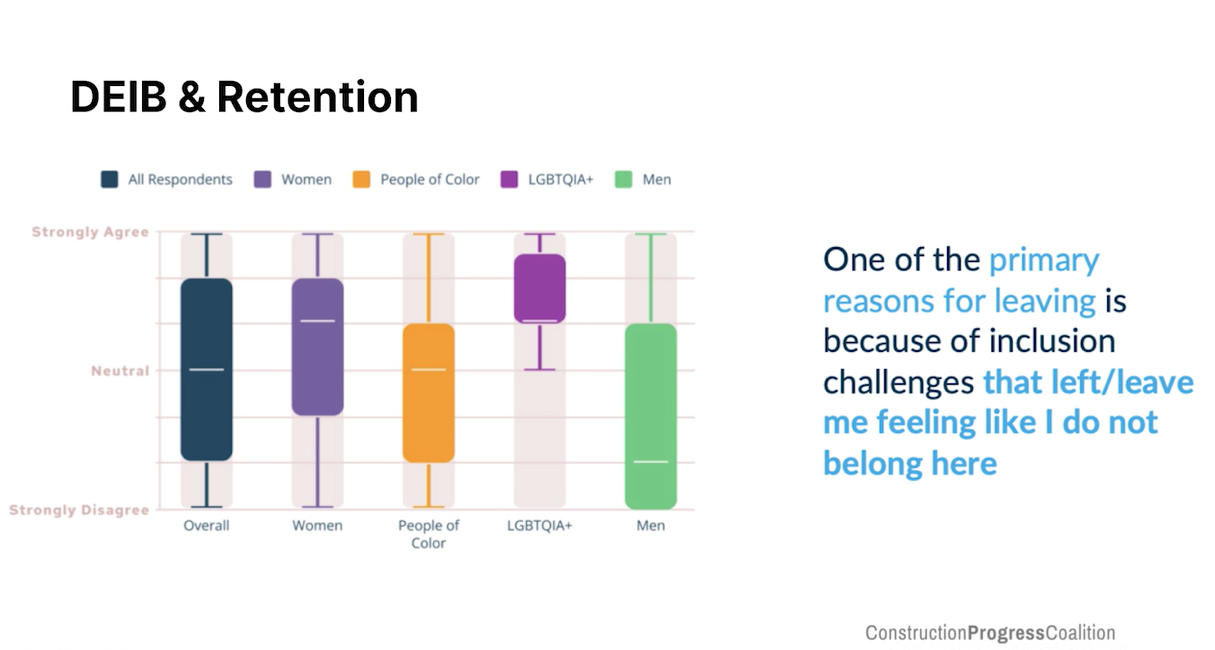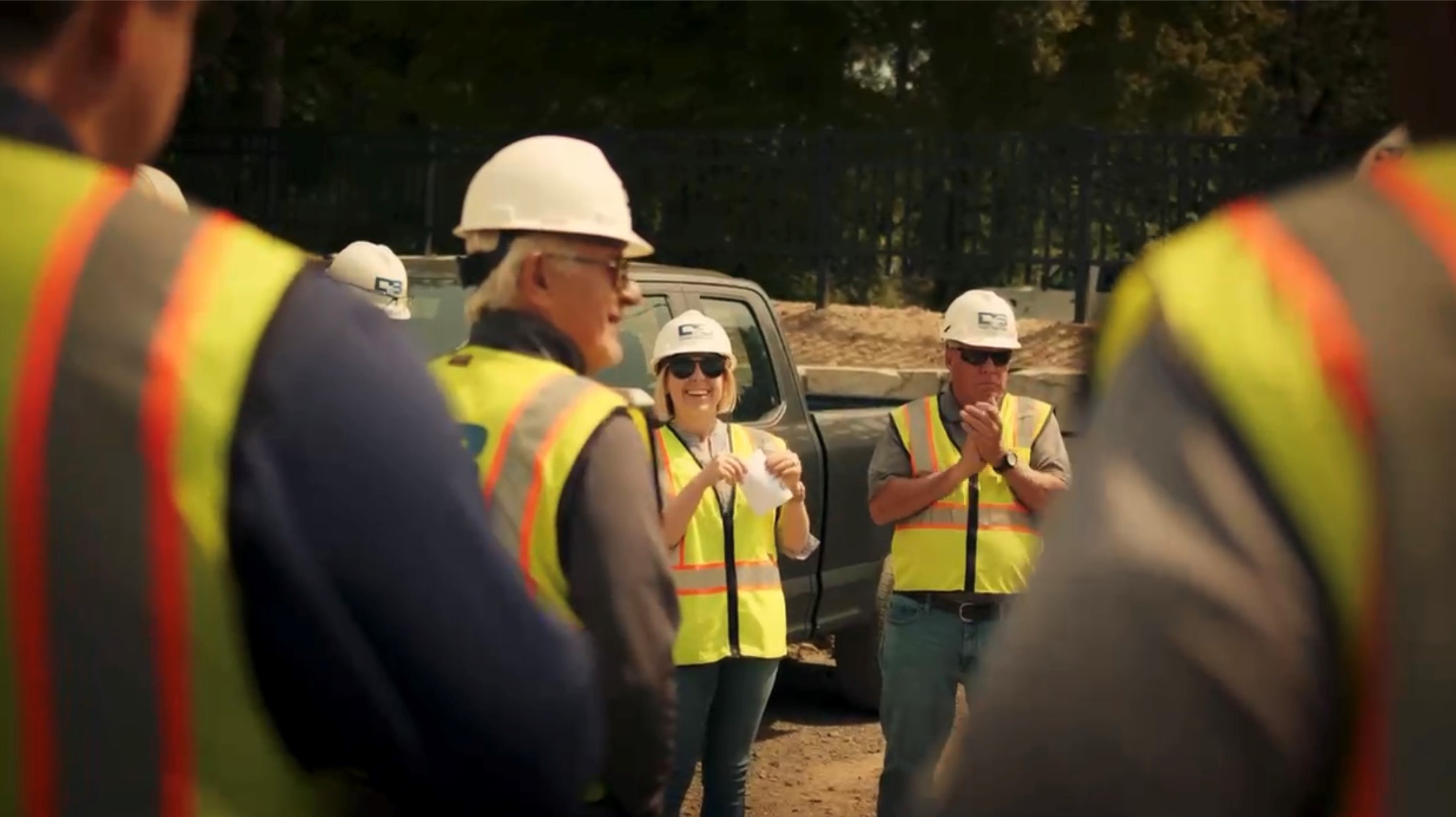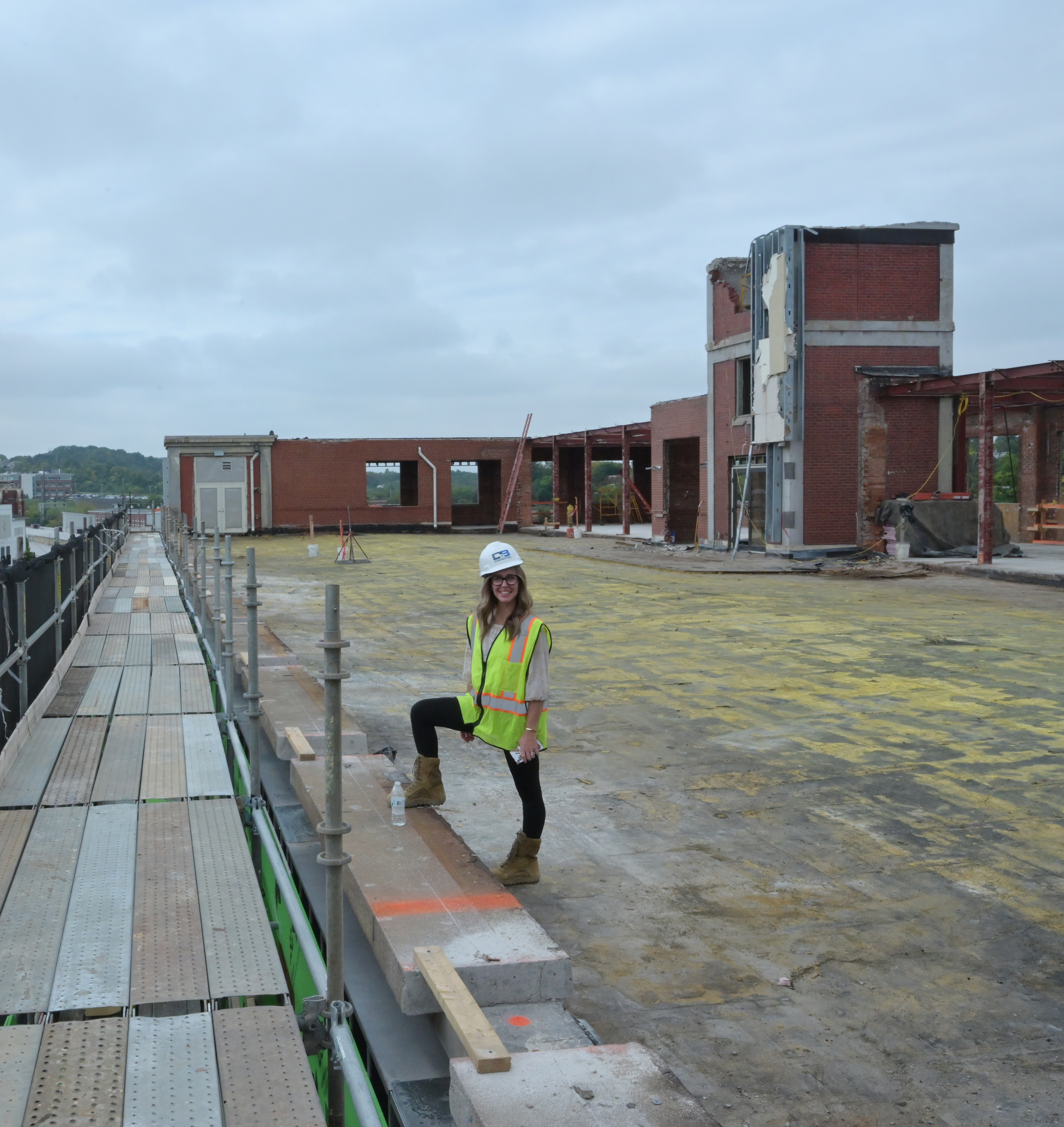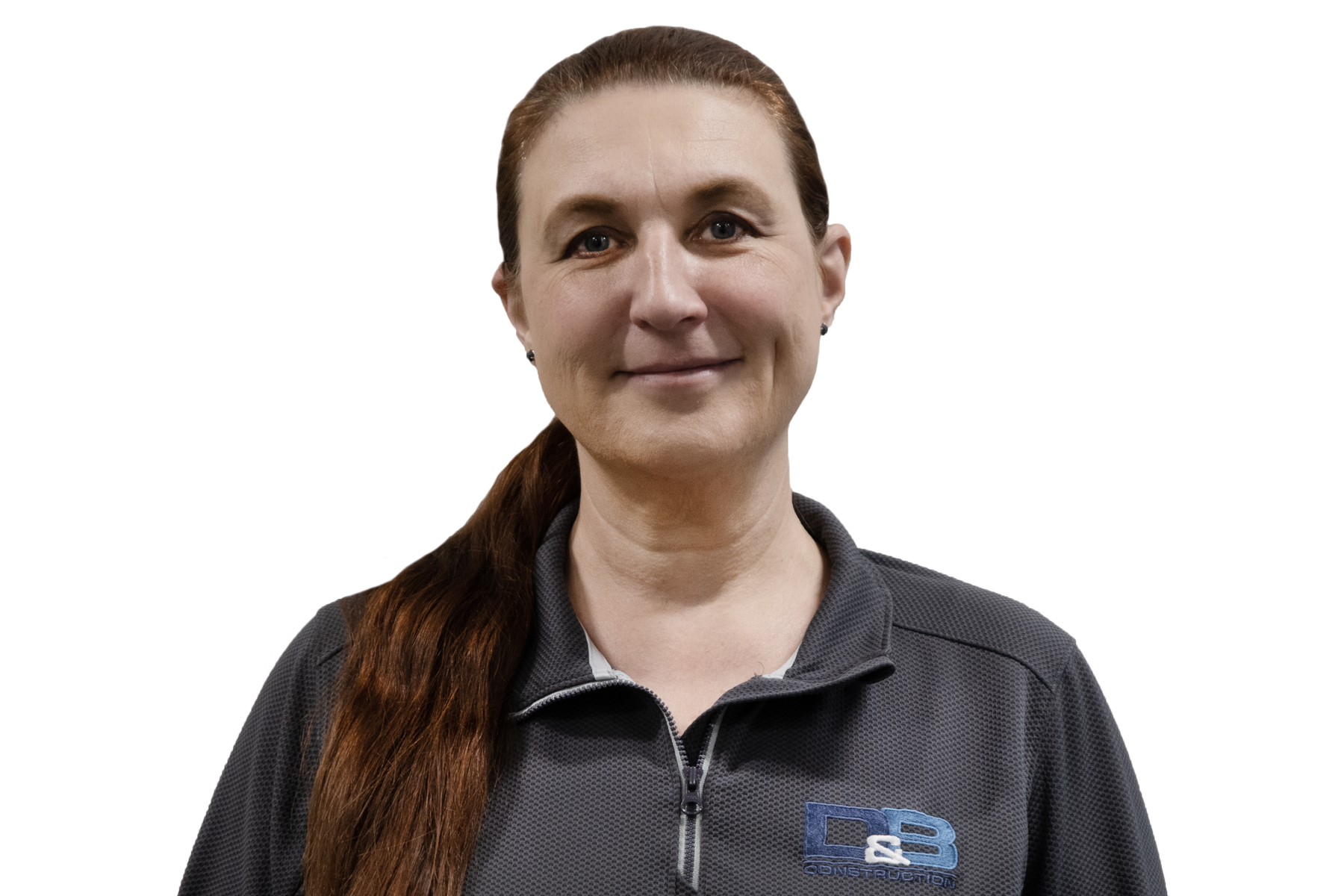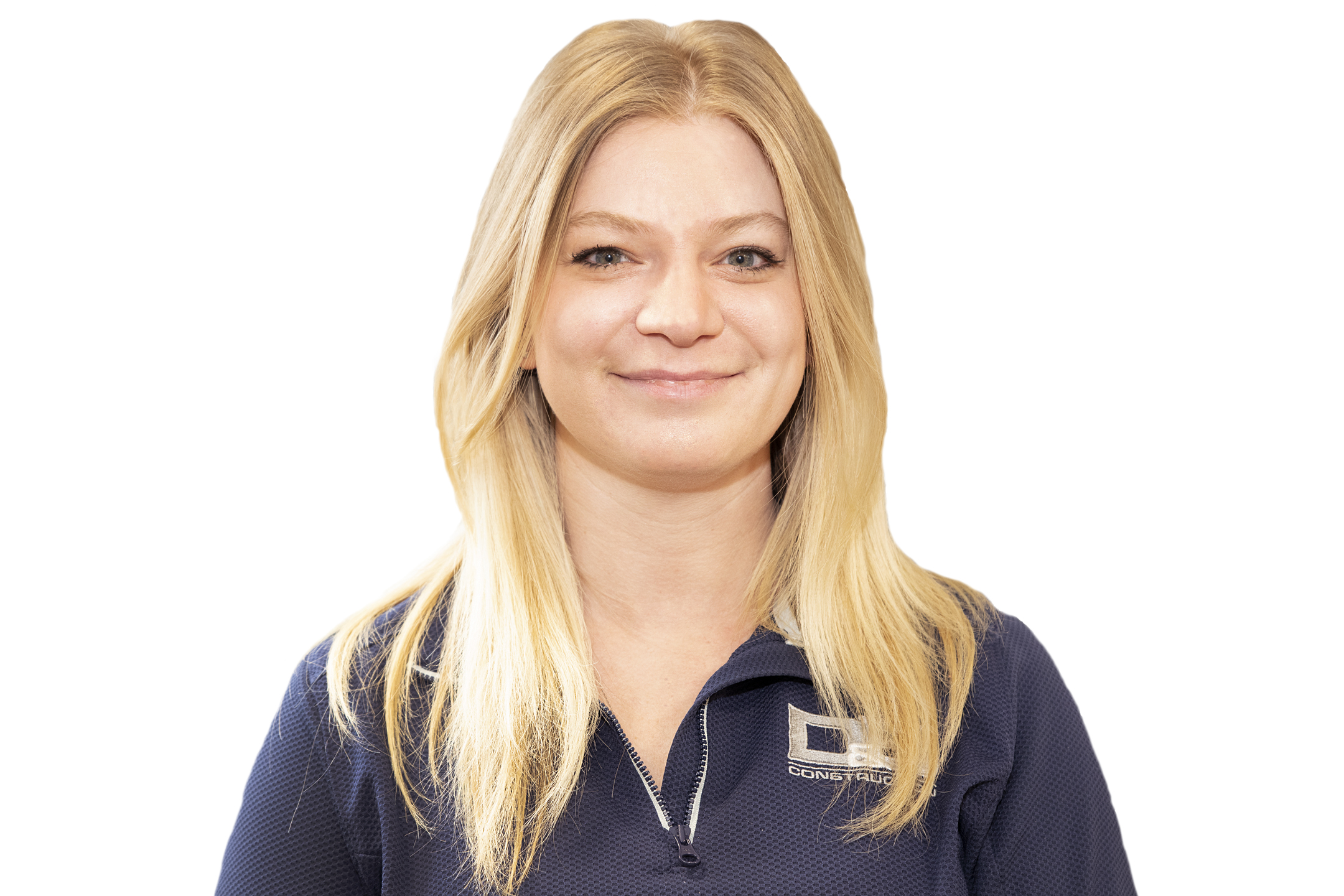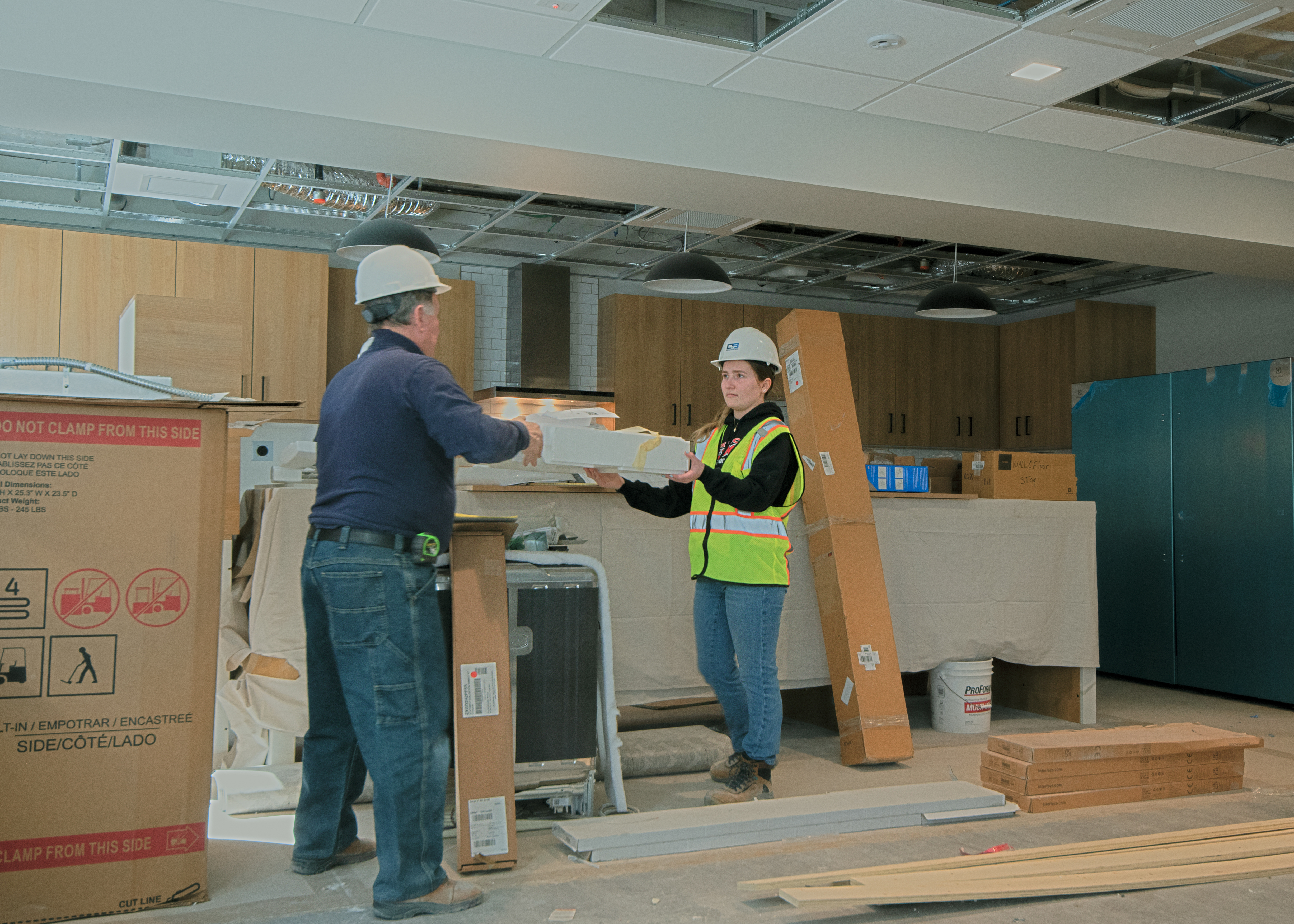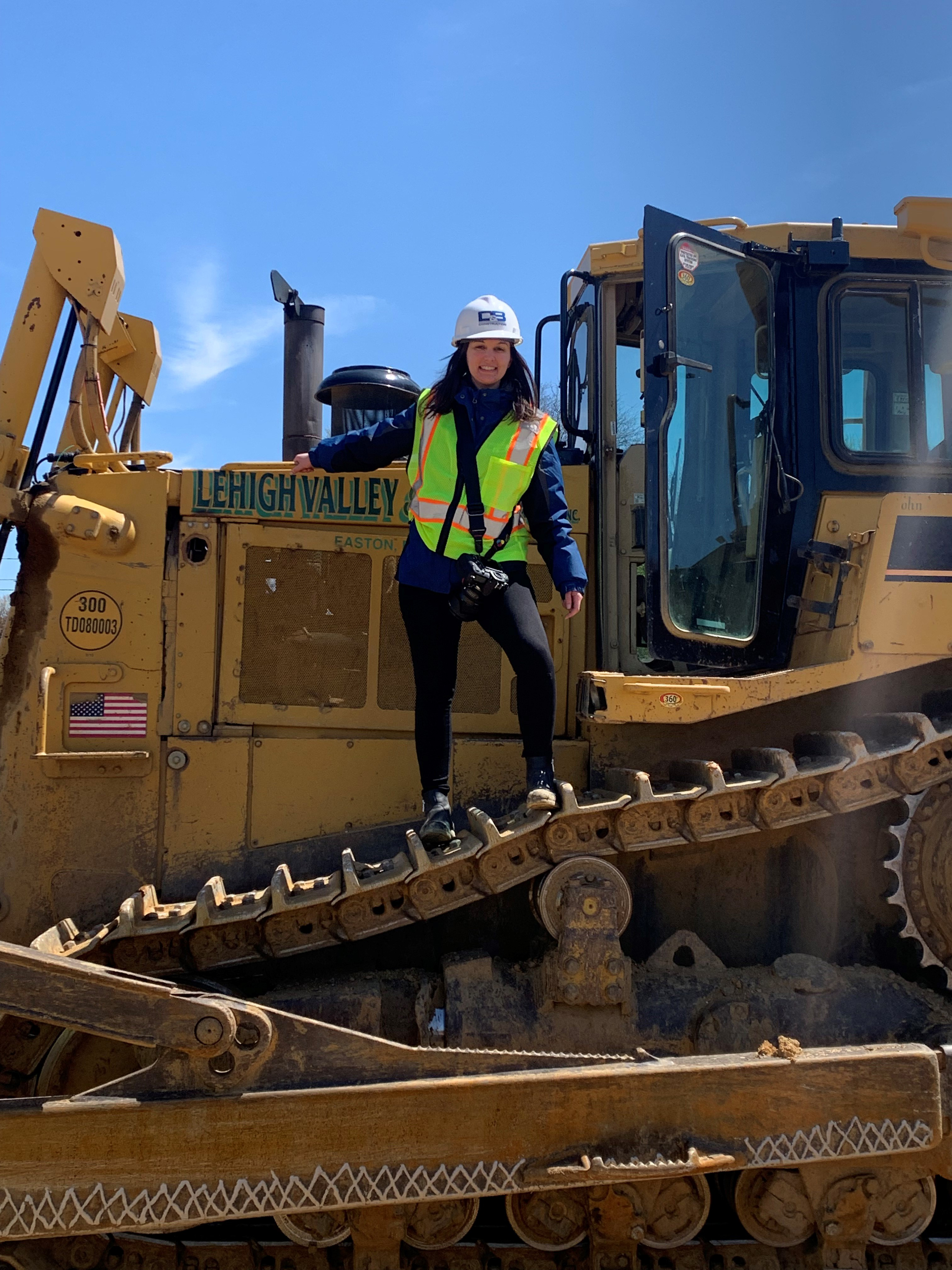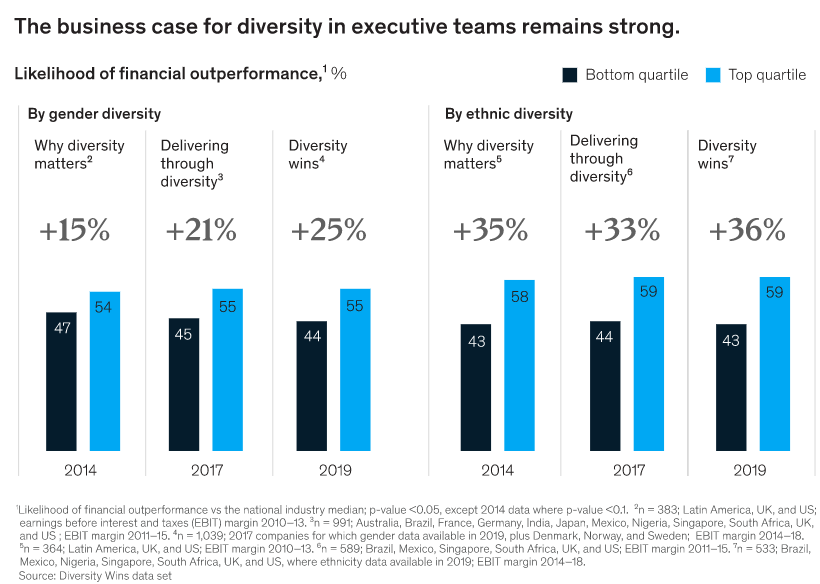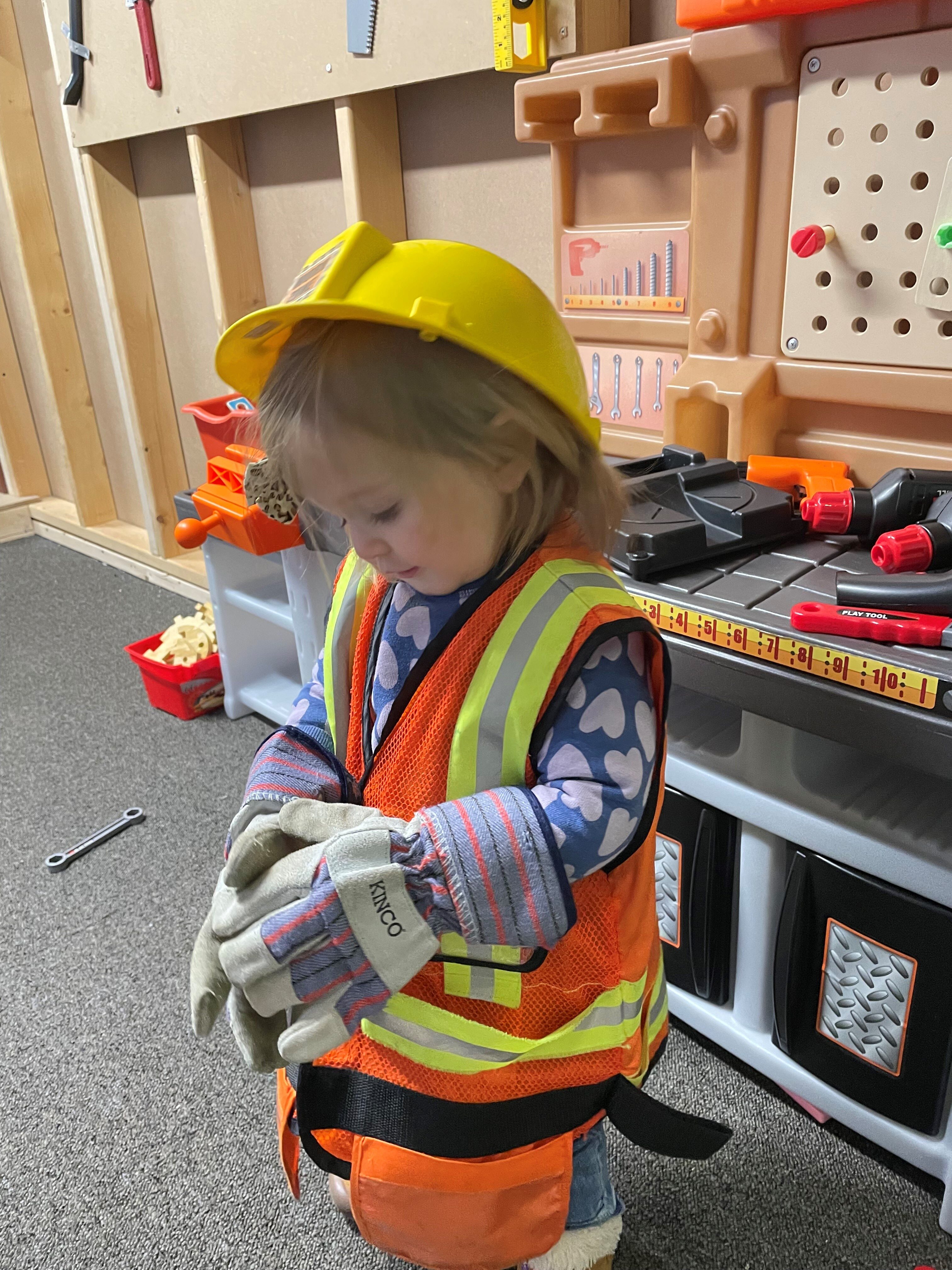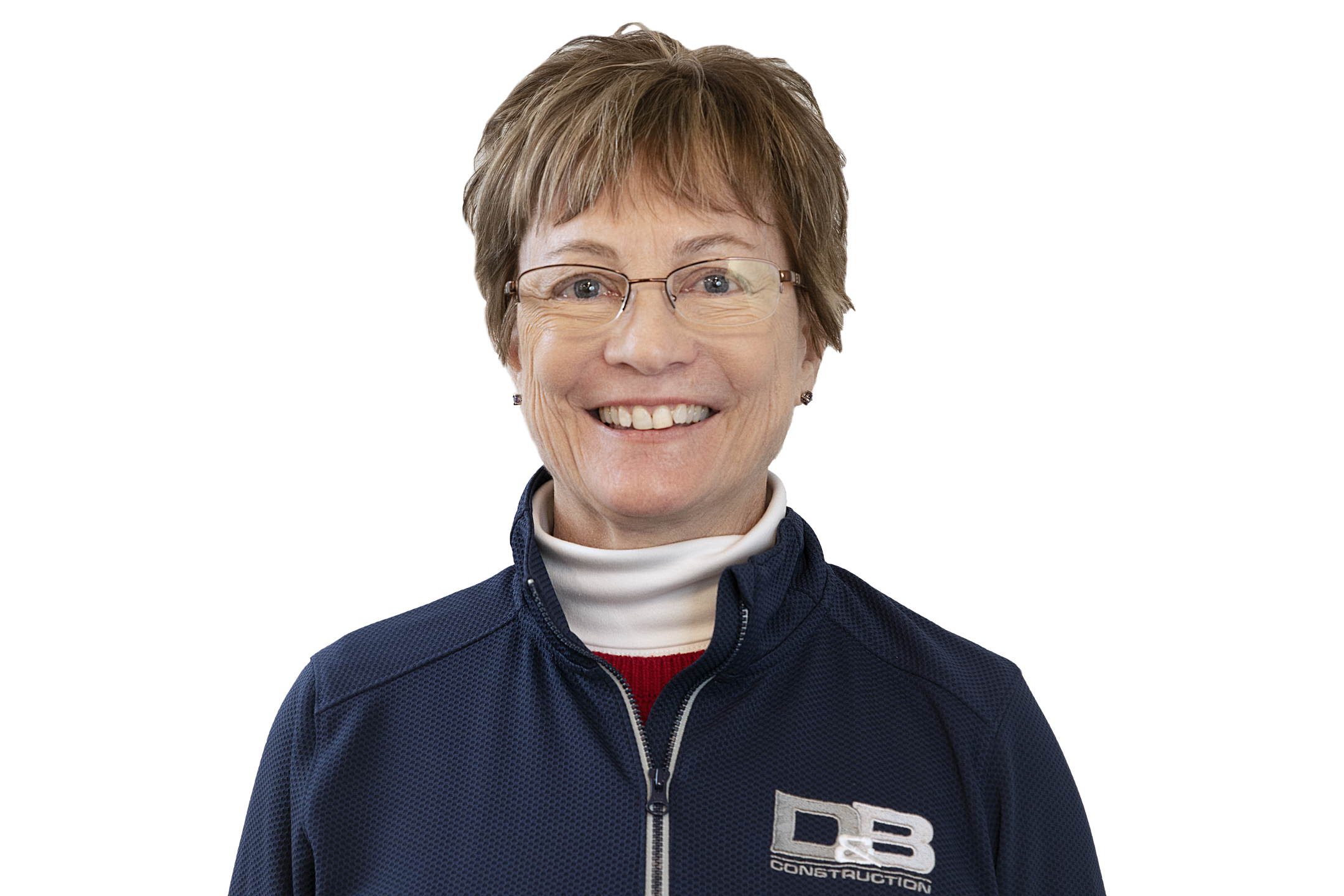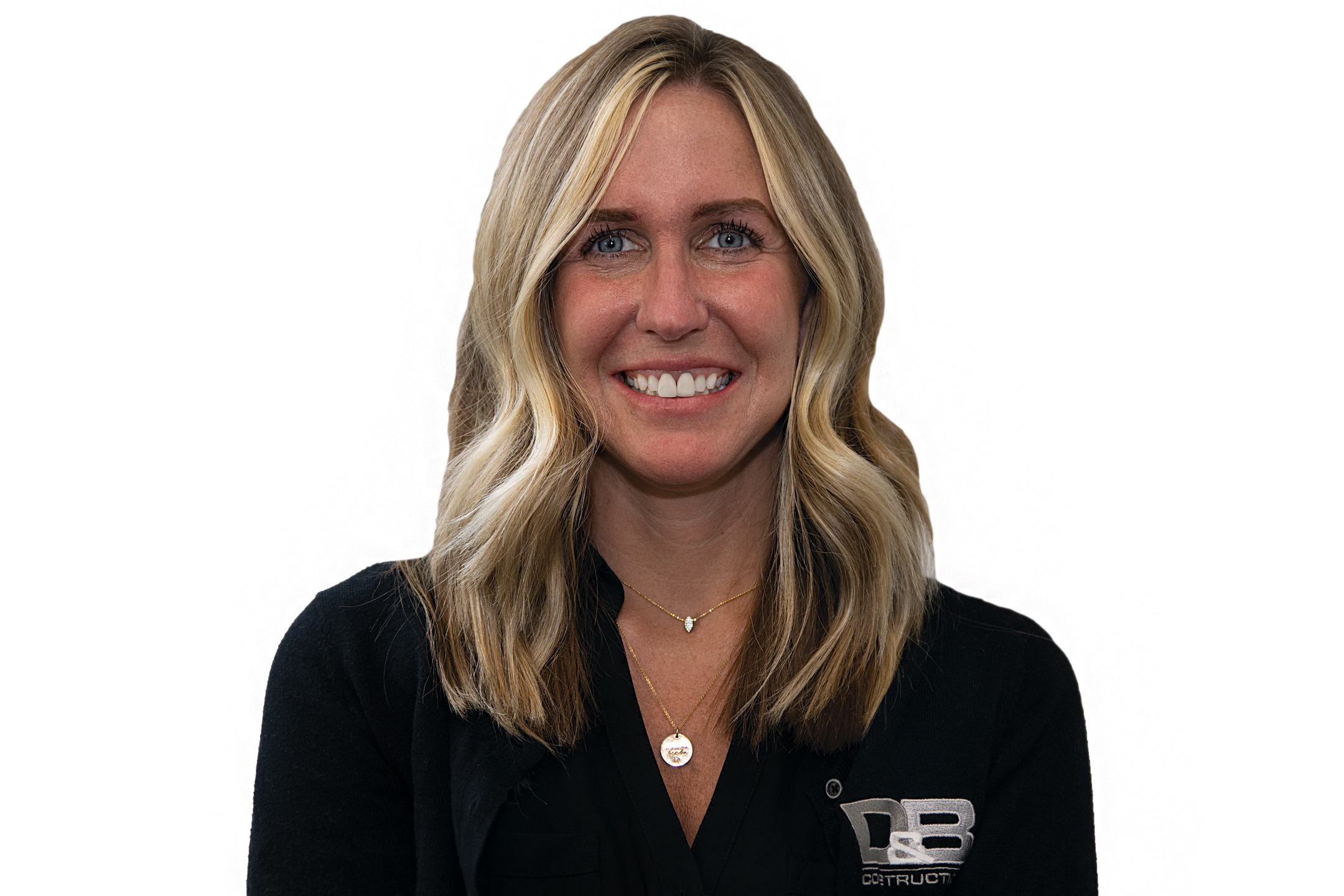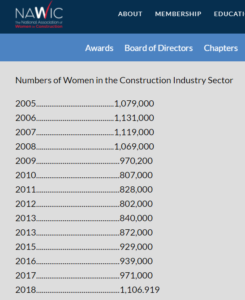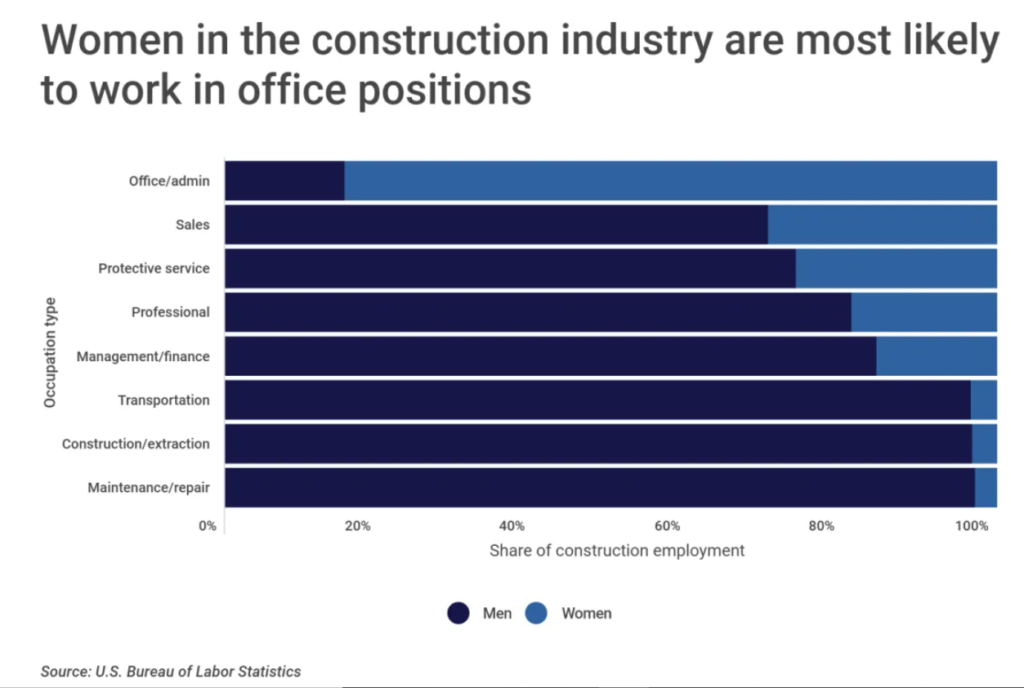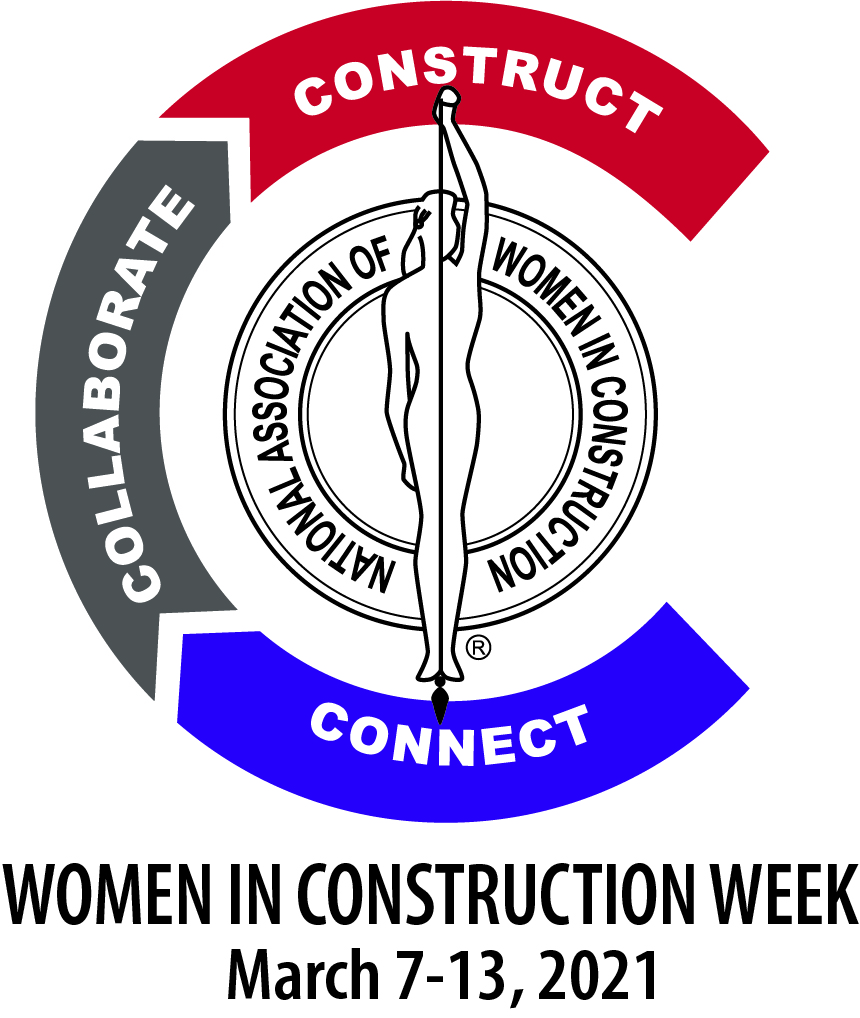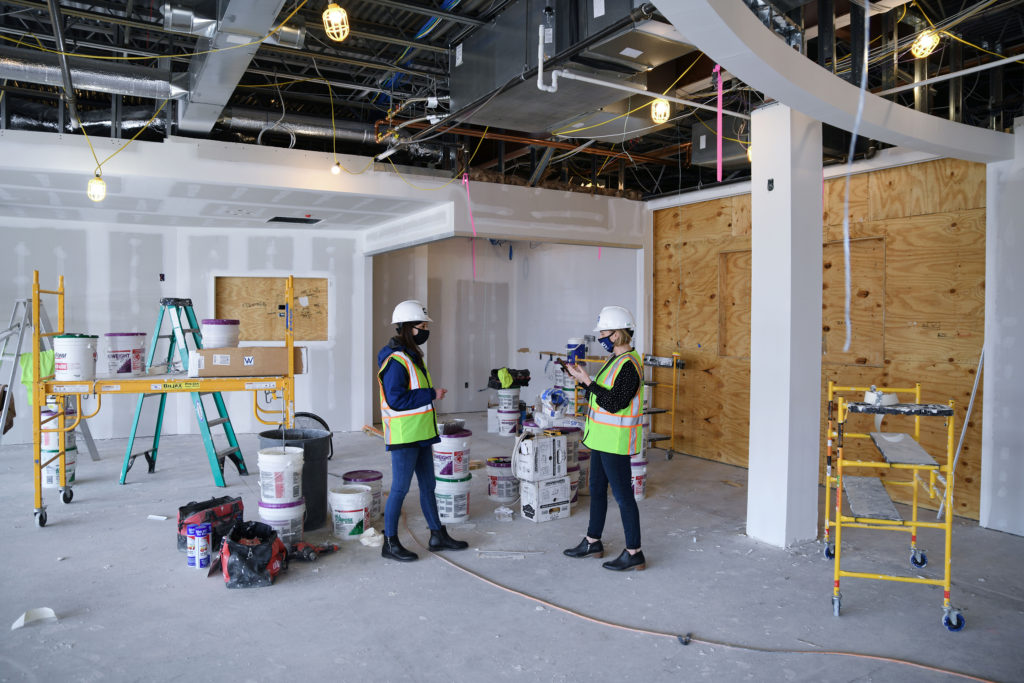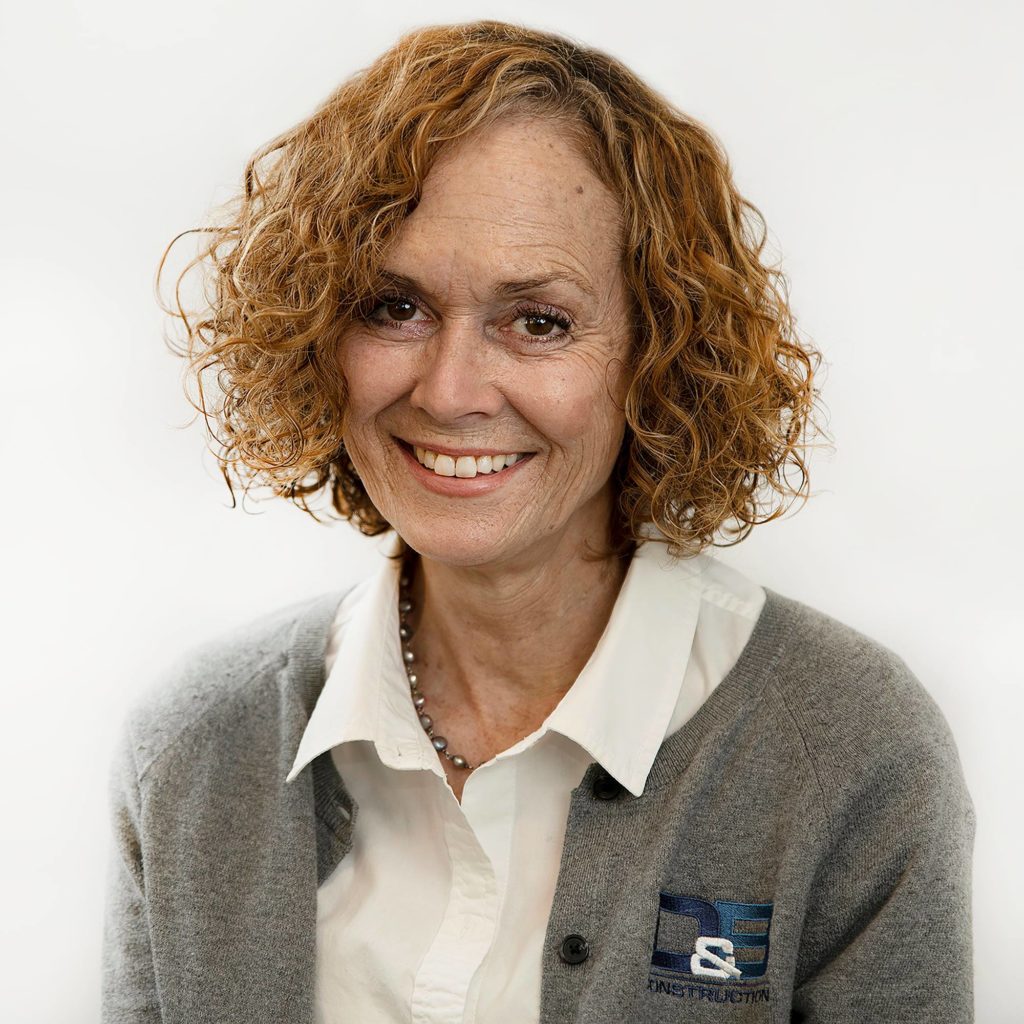According to the Bureau of Labor Statistics, “the share of construction workers who are women is at an all-time high and has steadily increased since 2016.” The Washington Post has found that as of August, 14% of all workers in the industry are women. (The last time this number was this high was in October of 2009 when they made up 13.5% of workers).
In October of 2022, the U.S. Secretary of Commerce, Gina Raimondo, announced the Million Women in Construction Initiative while speaking at the North American Building Trades Union’s Tradeswomen Build Nations Conference. The goal is to double the number of women in construction from one million to two million over the next 10 years.
Despite this positive news, a recent survey revealed that both women and underrepresented groups tend to leave construction at a higher rate. This study was completed as a way to solve the talent retention dilemma being seen across the industry. (Some background: In May of 2022, the Associated General Contractor of America (AGC) recorded the “highest number of construction job openings since the turn of the century.” Simultaneously, the Associated Builders and Contractors (ABC) analyzed data from the Bureau of Labor Statistics, which showed that construction employees are quitting at twice the rate of layoffs or discharges. This trend has been consistent for the last 16 months).
You can view the full report analyzing the data collected from this survey here!
This past Wednesday, Procore hosted a webinar called “The Data on Diversity and Women in Construction.” Members of Team D&B attended to uncover reasons behind the industry’s retention problem and also celebrate the significant milestones in representation. One of the speakers in attendance was Betsy Bagley, Co-Founder and Director of Pulsely, an organization that helps companies measure and monitor the progress of their DEI efforts and the impact it has on business performance. She pointed out how the study revealed that “yes, everyone wants career advancement and better pay, but inclusion is also a driving factor that the typical woman was likely to attribute to their reason on deciding to leave the industry. Far more women agree that inclusion is a challenge that plays a role in them deciding to leave the industry.”
A University of Maryland study published in October 2022 shed light on the visible gender imbalance in construction. It revealed that “54 percent of women who achieve leadership roles in construction have advanced degrees, compared to just 31 percent of men. Additionally, women typically work for 56 percent more companies and hold 19 percent more job titles than their male counterparts.” These disparities clearly illustrate the additional steps women are often forced to take to advance their careers.
In order to continue the trend of increasing women in construction and showing women that they already have a place on job sites, it is important that we collectively make change happen. In the webinar provided by Procore, Pulsely’s Co-Founder and Director, Betsy Bagley, noted that “people working in the industry are committed to the industry. They just want to see change from their employers.” Today’s workforce wants organizations to take it a step beyond just addressing how inclusion looks. They want companies to meaningfully address how inclusion feels.
Here’s Some Ways To Get The Job Done:
-Companies can enroll their female employees into their local chapter for The National Association of Women in Construction (NAWIC), which provides professional development, networking, education, leadership training and more to women throughout the Nation. There are 118 NAWIC chapters across America for women in the industry to get involved in. You can learn more about the history of this organization, as well as resources for women by heading to our #WICweek blog from last year.
-Boost innovation by boosting inclusion. Inclusion matters not only for obvious reasons, but it can also affect a company’s bottom line. According to a BCG study, companies with higher levels of diversity get more revenue from new products and services.” Likewise, a study by McKinsey revealed that “companies in the top quartile for gender diversity on their executive teams were 21% more likely to experience above-average profitability than companies in the fourth quartile.”
-Hold people accountable for behavior that is less than inclusive or inadequate. Visible Diversity, Equity and Inclusion – or DEI leadership – that shows commitment to the priorities of DEI goes a long way.
-Offer more structured career development and be more deliberate and intentional about offering fair career development for everyone.
The future of construction will heavily be defined by how our industry addresses the inequities discussed in this article. At D&B Construction, we believe that empowering all of our employees to feel included so they know their company is committed to their continued success is vital not only for our continued success as an organization, but our collective success as an industry.
A Q&A With The Ladies Of D&B:
We asked some of the women on Team D&B to offer their insight. See what they had to say below! You can view other features from years past here and here on our blog.
Meet Jessica Nelis, Director of Operations –
Number of Years in the Industry: 15
How She First Got Started in the Industry:
“I started by taking drafting, engineering and art classes in high school and went to college to major in design. After college, I worked as a designer at an architecture firm and then switched into project management.”
Q: Is this industry one you always wanted to be involved in?
A: “I first started to consider design & construction in high school, although I wasn’t exactly sure which specific path within the industry I wanted to take. I enjoyed both art and science throughout high school and thought this industry was the perfect crossroads of left brained and right brained thinking. I am intrigued by the concept of an idea coming together in a practical and aesthetic way to solve a problem with a tangible and lasting result.”
Q: What do you love most about your job and why?
A: “What I love most about my job is the continual growth – both for the company and me personally. D&B has been on a steep growth trajectory since I started here 5 ½ years ago. When I was hired, there were only 15 employees so everyone wore many hats. I worked as both an estimator and project manager in residential and commercial construction. I was exposed to many different project types and facets of the business. My diverse experience throughout a variety of departments and divisions provided me with a unique perspective and position to support the company with first-hand knowledge of our systems and processes.”
Q: What do you love most about the industry and why?
A: “I love being involved in an industry that is so critical to people’s lives. Buildings are essential to communities and families. They’re where we live, learn and conduct business on a daily basis.”
Q: Women make up only about 10.9% of all workers at a construction site in the U.S. What makes you proud to be a woman working in this male-dominated industry? How do women add value to this male-dominated industry?
A: “Women add value because they offer a unique perspective. Studies show women tend to be more web thinkers than men so being able to connect the dots across the big picture is helpful in STEM based industries such as construction.”
Q: If you could go back and tell your younger self one piece of advice that you know now, what would it be?
A: “Don’t overthink it or second guess yourself; just do it… with confidence!”
Q: Do you feel there is now more women in the field compared to when you first began in the industry? Why / why not?
A: I am encouraged to hear more young girls are entering STEM related fields, which gives me hope for the future! It’s a great field to consider for women – studies show the pay gap is smaller in construction than most other industries.
Meet Rachel Hope, Office Coordinator –
Number of Years in the Industry: 2
Q: Is this industry one you always wanted to be involved in?
A: “I never pictured myself working in the construction industry (administration side), and I was nervous changing my medical career to this industry but I could not be happier I made this move. I have learned so much in the last two years, and I am thankful for the time our team has taken to answer and teach me everything and anything I need to know about construction.”
Q: What do you love most about your job and why?
A: “Being the point of contact and keeping the office running as smooth as possible for everyone to work efficiently with office supplies and have necessities at hand. Also, I am so happy to learn how marketing works, help to schedule meetings for the team, and volunteer in our community when time allows. I’m so happy to be part of such a great team.”
Q: What do you love most about the industry and why?
A: “I love seeing the before and after of finished projects. I am amazed how one day I am driving past a cornfield and a year later seeing families living in houses, making memories in that same spot. Everybody has such an important job to make these projects a reality.”
Q: Women make up only about 10.9% of all workers at a construction site in the U.S. What makes you proud to be a woman working in this male-dominated industry? How do women add value to this male-dominated industry?
A: “Women in the construction industry bring a lot to the table. We were born multi-taskers, we can balance and juggle duties, and we have great organizational skills. Women need to build one another up and help one another succeed in this career.”
Meet Anna Velinsky, Estimator –
Number of Years in the Industry: 18
How She First Got Started in the Industry:
“My dad was a structural engineer, and as a kid I always saw him at the draftsman table. I think my first ‘construction’ drawings were plans I drew for a bird house at the age of 5 sitting next to him at that huge table with weird arms and rulers. It fascinated me.”
Q: What do you love most about your job and why?
A: “Every project is as unique as the people who the project is going to serve. It is never boring.”
Q: What do you love most about the industry and why?
A: “Making a dream of a building become a reality. You are part of creating something that people use and everyone can see and appreciate.”
Q: Women make up only about 10.9% of all workers at a construction site in the U.S. What makes you proud to be a woman working in this male-dominated industry?
A: “Despite it being a male dominated industry I’m not treated any differently and respected for my abilities. I find it’s a very meritocratic industry where anyone can succeed no matter what gender they are. There’s a true equality in opportunity for women. I’m proud to be a part of it.”
Q: How do women add value to this male-dominated industry?
A: Women have natural abilities to be detail oriented and good at multi-tasking.
Q: If you could go back and tell your younger self one piece of advice that you know now, what would it be?
A: “Be confident in your abilities. The world is full of possibilities. Go for it!”
Q: What advice would you give to women looking to enter the industry?
A: “The industry will always require qualified and talented people. There’s no better time to consider construction industry as a very rewarding career choice.”
Q: Do you feel there is now more women in the field compared to when you first began in the industry? Why / why not?
A: “Yes, I see a lot more women in all construction related professions. Women are attracted to rewarding long term careers where they can be financially successful.”
Meet Melany Eltz, Commercial Project Coordinator –
Number of Years in the Industry: 1
How She First Got Started in the Industry:
“My involvement in the construction industry first started when working for a retail store fixture manufacturing company. How something starts as a paper drawing and ends up as a complete fixture in a certain amount of time amazed me.”
Q: Is this industry one you always wanted to be involved in?
A: “Not at first. I wanted to be involved in the pharmaceutical science industry and changed my interest to marketing and business management. From there, I landed in the manufacturing industry, which then lead me to the construction industry which I didn’t realize would be so exciting!”
Q: What do you love most about the industry and why?
A: “There is a lot of variety which keeps it interesting, and I am always learning something new.”
Q: Women make up only about 10.9% of all workers at a construction site in the U.S. What makes you proud to be a woman working in this male-dominated industry? How do women add value to this male-dominated industry?
A: “I’ve always considered myself a strong woman in a man’s world. It is a good feeling to be accepted in this industry as a woman, and I am proud to be working together with men. Women are naturally adept at reasoning and listening, which I feel is integral to building good relationships and trust with workers, contractors, and vendors. I also feel women add value by staying more organized.”
Q: If you could go back and tell your younger self one piece of advice that you know now, what would it be?
A: “Never be afraid of trying anything new; keep your head up and persevere.”
Q: What advice would you give to women looking to enter the industry?
A: “In any industry, be confident in yourself, respect those who are more knowledgeable and learn from them. You’ll eventually gain their respect as well.”
Meet Maddie, Construction Intern –
Number of Years in the Industry: 1
How She First Got Started in the Industry:
“My first experience in the construction industry is now with D&B through my internship. I chose this internship opportunity because it would give me insight into all of the different occupations, and I get to see the different types of employees that work together in the construction process.”
Q: Is this industry one you always wanted to be involved in?
A: “I knew that I wanted to be involved in either the engineering or architectural side of the construction process since middle school, but it has only been this year through my internship with D&B that I decided I want to go into residential architecture.”
Q: What do you love most about your internship and why?
A: “I love that I get to see the construction and on-site side of the design process because I will see less of this side of the industry in college and once I start my career as an architect. However, I still need to understand this side of the process to be successful, so this experience is very valuable.”
Q: What do you love most about the industry and why?
A: “My favorite thing about the industry is how many people of different job types and backgrounds get to work together in one company or on one project to make the process run smoothly.”
Q: Women make up only about 10.9% of all workers at a construction site in the U.S. What makes you proud to be a woman working in this male-dominated industry? How do women add value to this male-dominated industry?
A: “I am proud to be a woman in this industry because it is an accomplishment to be able to thrive in a male-dominated industry – especially being younger. I believe women provide a different perspective to the industry and bring new and successful ideas.”
Q: What advice would you give to other women looking to enter the industry?
A: “I would tell them to be confident. Even when they may not think so, they belong here and should stand up for themselves. Always ask questions because you can always learn from others around you.”
Meet Angela Cremer, Marketing and Communications Coordinator –
Number of Years in the Industry: 2.5
Q: How did you first join the industry? Is construction something you always wanted to be involved in?
A: “I found myself in this industry as a result of COVID-19. Prior to this, I worked on the corporate marketing team of Boscov’s, a large retail department store. When the pandemic hit, we were laid off and thus my job search began. I never really set out to join the construction industry. When I joined D&B, I had not previously worked for a construction company and had little construction knowledge. I had done marketing, PR, and branding for a variety of other industries, from restoration and retail to many nonprofits, so it was a learning curve – and one I’ve thoroughly enjoyed. I regularly am going on jobsites to document the progress, so in the last two years I’ve become more confident in my knowledge through OSHA training provided by D&B and just gaining the experience that comes with time.”
Q: What do you love most about your job and why?
A: “I find the responsibility of marketing a construction company fun and rewarding. It is such a neat process to document a job from start to finish.”
Q: What do you love most about the industry and why?
A: “There’s so much that goes into a construction project before mobilization happens and before boots even hit the ground. I love being part of the ins and outs of this process and seeing our team create new buildings or breathe new life into old buildings throughout our community is gratifying.”
Q: Women make up only about 10.9% of all workers at a construction site in the U.S. What makes you proud to be a woman working in this male-dominated industry? How do women add value to this male-dominated industry?
A: “I’m proud of the women in this industry because they are breaking glass ceilings every day. There’s research and data that prove a positive correlation between companies with a more gender diverse leadership team and profitability. I think that tells you everything you need to know about how women add value to a male-dominated industry.”
Q: How can male leaders within the industry empower their female colleagues?
A: “By evaluating a woman’s job performance by the one relevant factor – her work product. How she looks or dresses or other personal factors should not play a role. Simply treating women as equals in the field goes a long way. I recently completed volunteer work with co-workers that involved installing cabinets to renovate a nonprofit’s kitchen. As an office worker, I wasn’t treated differently than my male co-workers in the field. They were all willing to teach me the proper way to use certain tools and offer insight without judgement so I could gain hands-on construction experience.”
Q: What advice would you give to other women looking to enter the industry?
A: “A recent article I read stated: ‘For women, advancing in the AEC industry generally means having to climb career ladders with more rungs than men of similar status.’ Don’t let the visible gender imbalance in construction stop you from achieving your goals. Instead, use it as fuel to light your fire. The view from the top once you break the glass ceiling will taste that much sweeter since you worked so hard to get there.”
The old perception that construction is a “man’s job” is outdated, and there’s no better time to shed a light on why that is than during Women in Construction week. You’ll find women leading multi-million-dollar job sites and overseeing operations for construction companies across the country. With supportive employers, they’re also building a more inclusive industry.
What is Women in Construction Week?
Women in Construction Week always takes place during the first full week in March. The purpose of this week is to highlight the many great initiatives and work of women within the industry, while also illustrating all of the opportunities available to women in construction.
The history of Women in Construction Week is allied with the National Association of Women in Construction, which was founded in 1953 by 16 women working in the construction industry in Fort Worth, Texas. In 1960, just seven years after being founded, Women in Construction Week was introduced in honor of the association. The National Association of Women in Construction was initially created to “support the few women working in construction at the time.” The organization has since “gone on to ease the passage of women into construction, helping to create awareness and better working space for those who desire to work in the industry.”
Today, you will find 118 NAWIC chapters across the United states, all providing professional development, education, networking, leadership training and public service. We owe many victories in the industry to the 16 courageous women who started this foundation nearly 70 years ago. Some examples include the fact that the overall stigma of women working in the industry has reduced tremendously, and the pay gap between men and women is relatively small when compared to other industries.
Resources For Women In The Industry:
To learn more about resources for women in the industry check out our Women in Construction Week blog post from last year here on our website. We always like to refer people to the two nationally recognized groups that provide networking and mentorship opportunities for women in the industry: Women Construction Owners & Executives (WCOE) and the National Association of Women in Construction (NAWIC).
We also happen to love NAWIC’s official podcast, Build. Lead. Succeed., which you can listen to here! The newest episode features an interview with Laura Jones, Project Manager with WW Gay Mechanical Constructors, and discusses what it takes to be able to accomplish maximum career growth while raising children.
Another vital resource? Giving our women in construction access to mentors! LeadHeralliance.com is on a mission to do just that. This program offers monthly sessions, workshops, meet ups and networking opportunities, and was created by women for women. By joining as a mentee, ladies will belong to a network of women in the construction trades. They can be “matched” with their own professional personal female Mentor, who will help grow their career. The group is also always looking for mentors to help recruit, retain and support females new to the construction trades. Feel free to connect with Sarah Hilton, Director of Programs, to learn more!
How Women Help Grow The Industry:
Research has shown that organizations with above-average diversity had 19% greater innovation revenues. There is a clear positive relationship between innovation and diversity, as depicted by The Boston Consulting Group’s survey on diversity, which spanned across 1,800 companies in eight different countries.
If you are alive in today’s world, chances are you aware of the workforce shortage issue. According to the Bureau of Labor Statistics, approximately 400,000 new jobs will be added to the construction industry from 2020 to 2030. One solution to this growing problem is recruiting women, who make up 47% of the total workforce. It is not only smart – but necessary – to employ, educate, and support women construction workers. Doing so helps ensure long-term industry progress.
Another report by McKinsey & Company revealed that gender-diverse companies are 25% more likely to achieve above-average profitability than companies with less diversity in their Diversity Wins report from May 2020. One highlight in particular that stands out from this report? When women filled 30% or more executive-level positions in a company, the companies were 48% more likely to outperform their least-diverse competitors.
A study by the National Bureau of Economic Research revealed that women are more likely to collaborate than men, a trait highly sought out in construction management since there is no doubt that construction projects require a high level of collaboration. The increase in teamwork and cooperation that women bring to the table can lead to significant improvement in a company’s productivity and profits.
Women’s ability to be great listeners and communicators and to pay attention to tasks that require precision for longer periods of time make them valuable employees on the job site, too, where tasks such as framing require great accuracy.
Overall, adding a woman’s perspective to a male-dominated world can bring a new approach to how things can get accomplished. Their input is valuable and beneficial, and they can greatly help to improve interpersonal relationships.
Despite the many advantages that women bring to the table, only 7% of architects and engineers are women, 5% of contractors are women, and 4% of construction managers are women. Below are some reasons as to why this may be given the set backs women have historically had to face:
Pay Gap: Historically, statistics reveal that 43% of organizations don’t actively monitor gender pay gaps. However, this trend has slowly been reversing. The National Association of Women in Construction recently reported that “women earn an average of 99.1% of what their male counterparts make in the field.” It has been reported that women working in construction and trade earn 30% more than those working in women-dominated occupations.
Gender Bias: Women are the victim of 60% of gender discrimination cases in the workplace.
Lack of Advancement: Over 70% of female construction workers have felt passed over for roles because of their gender. Women only make up about 14% of staff executive and 7% of line executive positions. The good news? In 2018, it was reported that nearly one in three companies promoted women to leadership roles and other executive-level positions. According to NAWIC, “a significant percentage (44%) of women currently employed in construction projects work as construction managers and other management professionals.”
Ways To Empower Women In The Industry And Those Looking To Join:
Lead by example. Help the women on your team feel like part of the solution (because they are). Treat all workers equally – with respect and courtesy – at your construction site.
Provide the women in your industry with female mentors or role models within the industry to help them navigate workplace challenges. (Don’t forget to check out com if you are interested in having or being a mentor.) Did You Know: Over 45% of women in construction have never worked with female construction managers?! Reducing this shortage of role models would have a lasting impact.
Offer STEM mentorship. Statistics don’t lie and they show that when it comes to who is graduating with a construction management degree, men still “significantly” outnumber women. Why is this? The answer may come down to the simple point that women may not be presented with construction as a career option the way men are. Conducting outreach for young women interested in exploring the field is crucial. STEMblazers does this by inspiring girls to visualize themselves in science, technology, engineering, and math professions. They have a long term goal to reach 1 million girls and influence them to pursue a career in STEM so women can be equally represented in the STEM workforce.
Meet The D&B Ladies:
Last year you met Lesley, Jess, Beth and Angela as we celebrated WIC week. In a year’s time the ladies of D&B have since doubled. (Woohoo!) Meet Bryn Heist, RA (Project Manager), Rachel Hope (Office Coordinator), Melany Eltz (Commercial Project Coordinator) and Kellie Mackie (Estimator and Assistant Project Manager) for our sister residential company, D&B Elite Custom:
Meet Bryn, RA – Commercial Project Manager:
Bryn is a seasoned Design and Construction Project Manager and Architect. She joined Team D&B with nearly 40 years of industry experience. Bryn first joined the industry as an Architect serving clients before making the transition to Owner’s Rep, which allowed her to coordinate between the Design Team and Contractors. She is excited to continue to serve clients through her role as a member of the Contractor’s team with D&B Construction. Bryn’s career experience spans across an array of sectors including healthcare, commercial, institutional, industrial and residential construction. She has spent the last 20 years of her career with a focus in the healthcare industry as Senior Project Manager for Universal Health Services (UHS) and Project Manager for Tower Health Systems (Reading Health Systems). Throughout this time, Bryn effectively managed multiple projects ranging from $100K to $52M concurrently. She enjoys being involved at the inception of a project and seeing it through from construction to occupancy. Bryn appreciates the problem-solving aspect of design and construction, particularly the collaborative team efforts required to produce the end result of the process – an occupied building which fulfills the Client’s needs and exceeds expectations.
Q: What has been the most memorable moment in your construction career and why?
A: “Being the Sr. PM for the design and construction for a 100 bed 82,200 SF Behavioral Hospital facility which came in under budget and on schedule. The 5-acre site, fall start date in a mid-west region, REIT funding and a JV partnership provided multiple challenges. The Design and CM team were great collaborators and the relationship established and maintained with the City and State made this the success it was. The project provided much needed care for patients across the region, which were otherwise not served. Plus, the building functioned well and was aesthetically pleasing.”
Q: How do women enhance profits for companies and what do they bring to the table?
A: “Diversity in general, not just gender-related, is known to provide different backgrounds, skills and perspectives, all qualities which can enhance the workplace. Companies who are more diverse have a larger pool of applicants which lead to better talent. Diverse teams are known to perform better with improved decision making and new ideas. Increased creativity, skills and productivity impact the bottom line.”
Q: What are the advantages of being a woman in construction?
A: “Construction provides more variety than many other industries where women are often employed. It requires new skill sets, knowledge and experience, all of which creates a richer career.”
Q: What advice would you give to a young woman entering the industry?
A: “Learn as much as you can both in the classroom and in your work experience. Gain as much experience by accepting all reasonable opportunities. Speak up when you have something that can contribute to the team. Ask questions. Don’t be afraid of being in the minority. Listen and continue to learn.”
Q: Women make up only 10.9% of all workers at a construction site in the U.S. What makes you proud to be a woman working in the construction industry?
A: “Gaining respect from men who may not have worked with women up to that point after proving you are capable of the job and add value to the team. Leading the way for other women.”
Q: Has there ever been a time throughout your career in the industry where you felt you weren’t taken as seriously due to your gender / any specific stories you would like to share?
A: “There are always men who cannot accept a woman on equal ground. Just do your job the best you can and ignore what you can’t change.”
Q: Have you ever felt bothered that there aren’t more women in construction? Why / why not?
A: “No, I have not felt bothered because I’ve been in the design/construction industry for 40 years and see the great strides that have been made and continue to improve for women in all industries. The fact that you can purchase decent looking work boots says it all.”
Q: Do you feel you see more women in the field compared to when you first started working in construction?
A: “Twenty years ago, I was almost blatantly rejected as a hospital PM because of my gender. I was eventually hired for that position. Now the same company wouldn’t even consider that to be an issue. So yes.”
Meet Melany – Commercial Project Coordinator:
Melany is a testament to the fact that having a female mentor and role model can play a big roll in fulfilling a career in the industry. Melany’s mother has worked in the furniture manufacturing and cabinet industry for over 20 years, with 18 years in retail prior to that. She has a wealth of knowledge when it comes to retail stores, office fixtures, and residential spaces.
“I started helping my mom with computer data entry of client sales orders at the young age of 12. This allowed me to become familiar with what a manufactured piece of furniture was and how demands needed to be met. During and after college her business was looking for interns, so I was excited to be part of the company on a new level. Working with my mother for six years taught me how to talk to clients and co-workers to get positive results. She taught me that using kindness, patience, listening to others, never saying you could not help, and setting an example for her team equals respect and admiration. My mother works hard, delegates when needed, and manages people in a friendly way. As a result, people love working hard for her to get the job done on time, and she has a great client following from providing service in excellence.”
What advice would you give to young women entering the industry?
“Have confidence in yourself, know you worth, and know that a woman is the best man for the job.”
What do women bring to the table for their companies and the industry as a whole?
“I believe that women are creative, innovative and are not as rigid / ‘black and white’ as men. It’s the grey area that women seem to be able to think more outside the box and can maybe find more creative ways of making money or profits. Women bring sensitivity and compassion to the table, along with being well organized and having that overall drive to always do a job well to make clients and coworkers happy.”
Women make up only 10.9% of all workers at a construction site in the U.S. What makes Melany proud to be a woman working in the construction industry?
“The ability to excel in a ‘man’s world’ as a woman is exciting and rewarding.”
What do you think is the most important change currently happening in the construction industry and why?
“With the issues and challenges in this world today with material shortages, rising costs and delivery delays, the ability to focus on the big picture, exude patience and understanding and have the ability to reason with clients and co-workers is truly a must have.”
Meet Rachel – Office Coordinator:
Rachel joined Team D&B with 15 years of experience as an Optical Manager for an eye care office. Although she never worked in construction before joining our team nearly a year ago now, she can attest to the “big impact that having a strong woman leader in the work place has.” In the last year since she joined Team D&B, Rachel has “learned how to be strong, prioritize workloads on projects, the construction ‘lingo”, and the huge impact that safety has in the industry.” She is excited to continue to keep learning and growing in construction and is “pleasantly happy to see how many women have been working in this industry for a long time.”
What do women bring to the table for their companies and the industry as a whole?
“In doing some research, women have outscored men in their ability to take initiative and drive for results. Women have empathy, are mindful, can multitask and have open communication – all which are great traits and make teams more in sync.”
What do the women of D&B bring to the table for our clients, trade partners, and co-workers?
“The women of D&B build solid workplace relationships.”
What are the advantages of employing women in construction?
“Women can introduce new methods or approaches that have not yet been explored.”
What are some ways that male leaders within the industry can empower their female colleagues?
“Be sure women’s voices are heard (in meetings, especially), practice transparency, and listening.”
Meet Kellie – Residential Estimator / Assistant Project Manager:
Kellie joined our residential construction company, D&B Elite Custom, in September of 2021. Prior to starting her career with D&B, she worked at Griffiths Construction for nearly four years as a Project Estimator.
What has been the most memorable moment in your construction career and why?
“I have had many experiences in my career but most memorable would be the final walk through with a woman who was planning on moving her aging mother and handicapped brother into an ADA addition we completed at her house. To see the satisfaction in knowing she now could care for her mother and brother in a safe and comfortable setting right at her home was priceless.”
What do the women of D&B bring to the table for our clients, trade partners, and co-workers?
“In my experience women in construction bring just as much to the table as our counterparts! My experience values me, not my gender. I love the diversity our company brings to our clients. The gender stereotypical roles of the past are breaking down and we are seeing more females take the lead in designing, coordinating and actually performing the field work. This can only set the stage for future growth as D&B stands out among our competitors.”
What are some ways that male leaders within the industry can empower their female colleagues?
“Without the forward thinking of men in the construction field, women would not be able to achieve what we have to date. Since most of the construction field is male dominated, it takes a smart man to see past a woman’s gender and look at them for their experience and not their gender. I am thankful for the men at D&B who have succeeded in achieving this mind set and evaluate each individual on their skill sets and experience rather than gender.”
Insight From Our Executives:
In order to encourage more women to join the industry and lift up those already working in construction, it is important to have everyone amplifying the voices of women in construction. Dan Gring, Chief Executive Officer of D&B Construction and Drew Bell, Vice President of Business Development, offer insight on how male leaders within the industry can empower their female colleagues, how the industry as a whole can work to attract more female candidates, and more in their Q&A below:
The number of women that make up D&B’s growing team has doubled (from 4 to 8 women) just since last year’s Women in Construction week. How can the industry as a whole work to attract more female candidates?
DG: “Focus on women’s overall work experience versus just focusing on specific construction experience. There are so many industries that cross-over construction (Engineering, Design, Sales, etc). It is important to look at overall success versus simply construction background. Without changing to this broader thinking, we’ll be missing many well-qualified female candidates.”
DB: “I think the heavy influence of men in construction comes from trade schools. Boys/young men get pushed into the trades as a career much more than women. I think the construction industry as a whole should emphasize that working in the trades is an honorable, noble and lucrative career path for women as well.”
What do the women of D&B bring to the table internally for our D&B family?
DG: The experience, knowledge, and commitment our women bring to our overall team is extraordinary. Our women bring a great emphasis on culture and are committed to a true team atmosphere. The attention to detail to their day to day helps D&B keep on track to our mission and goals.”
DB: “A different and valuable perspective. It’s no secret that men and women’s brains have variations to digesting and using information. Our women in construction bring a can-do/get-it-done attitude that is a great asset. They also have a knack for details which is instrumental to keeping everyone on task and fully completing objectives.”
What do the women of D&B bring to the table externally for our clients, trade partners, and suppliers?
DG: “Communication is the most important thing when interacting with our clients, trade partners, and suppliers. Our female colleagues at D&B are some of our best communicators, and our clients and partners recognize this.”
DB: “Everything. Most importantly could be relatability. Many of our projects are for companies that are run and/or owned by women. The ladies of D&B help teach men on our team the best way for conveying information and asking the right types of questions to make sure everyone is on the same page.”
Why is equality in the workplace important? How does D&B work to shorten the gap of inequality?
DG: “D&B recognizes the need for equality in the workplace. It creates more positive and productive working relationships, creates brand reputation, and it attracts the best talent. D&B is working hard through recruiting and an overall brand to represent ourselves as a place where all people want to work.”
DB: “Equality is the best method to create the most cohesive office environment. Everyone’s input and experience are invaluable in making essential business decisions. It’s essential to secure a good balance of influence from men and women in every facet of life, particularly work.”
A report by McKinsey & Company revealed that gender-diverse companies are 25% more likely to achieve above-average profitability than companies with less diversity in their Diversity Wins report from May 2020. Why do you think this is? In your opinion, how do women enhance profits for companies?
DG: “By having a gender-diverse company you create those relationships with clients and business partners that help bolster reputation and sales. We believe gender-diverse companies help to increase creativity within the organization that sets you apart from the competition.”
DB: “It comes down to perspective. Everyone thinks differently. Diversity in ethnicity and gender is critical for having collective decision making. Women, from my experience are great at critical thinking. This plays a significant role in strategic planning and day to day project management.”
What are some ways that male leaders within the industry can empower their female colleagues?
DG: “Male leaders can empower their female colleagues to continue to give their thoughts and opinions as their message is powerful and creative compared to the ‘standard perspective’ of our construction industry.”
DB: “Listen, include and value. I feel it’s common for people to be dismissive of input from people who are perceived to be less skilled/experienced. It’s changing the perception that is key. Men should not be dismissive of a woman in construction because she didn’t cut her teeth by swinging a hammer or hanging drywall. Our female colleagues have learned from experiences throughout their own construction journey that has educated and solidified their understanding of our job’s demands.”
In addition to celebrating International Women’s Day this Monday, we’ve also been celebrating Women in Construction Week here at D&B!
It’s no secret that construction is a male-dominated field. In fact, according to the U.S. Bureau of Labor Statistics, only about 10.3% of workers in the construction industry are women. This number has stayed nearly stagnant since the 1990s (see statistics below from the NAWIC):
Across the nation, there are over 1.1 million women in the construction industry. Meanwhile, in a drastic comparison, men come in just shy of 10 million at 9.9 million. Click here to see Construction Coverage’s list of cities with the most women in construction.
Another doubtful secret is that women in the construction industry are most likely to work in office positions. For example, men make up approximately 20% of office / admin roles in the industry, while women make up about 80%. In contrast, men make up nearly 100% of occupations in the construction, extraction, maintenance, and repair fields.
Resources for Women in the Industry
We’ve compiled a list of some of the D&B ladies’ favorite resources for women within the industry. Be sure to give their social channels a follow to receive a number of resources.
The National Association of Women in Construction is the leading association for women in construction. Its humble beginnings date back to 1953 when 16 women working in the industry founded what was then known as “Women in Construction of Fort Worth, Texas.” Their goal was to create a support network for women. The organization’s success led to it becoming a national charter in just two years. Today, this organization is still based in Fort Worth, however it has grown exponentially with over 115 chapters throughout the United States. They are committed to championing women to impact the direction of the construction industry, while also strengthening and amplifying the success of women in the industry. They do this by providing education, community and advocacy for women builders, professionals and tradeswomen in all aspects of the industry. According to NAWIC, “The focus of Women in Construction (WIC) Week is to highlight women as a viable component of the construction industry. WIC Week also provides an occasion for NAWIC’s thousands of members across the country to raise awareness for the opportunities available for women in the construction industry and to emphasize the growing role of women in the industry. It is also a time for local chapters to give back to their communities.” The northeast region of the U.S. has 16 NAWIC chapters, with one in Philadelphia and a second in South Central PA. Learn more about becoming a member here, and view their resources here.
If you missed our first blog post, be sure to check it out to learn all about Xena workwear for women. This company is all about inspiring girls to pursue careers in STEM and the trades… and did we mention they are OSHA compliant while also being comfortable and stylish?! No wonder the ladies at D&B love them so much. See below for a picture of D&B team members, Angela and Jessica, rocking their Xenas on the job site for Riverfront Federal Credit Union.
We also love the Women in Construction Summit Blog, which serves as a great resource for women in the industry. While you are at it, have you checked out Women Construction Owners & Executives USA (WCOE)? Located in Washington D.C., they aim to provide a network of executive women in the construction industry for mentorship, peer-to-peer assistance, information and support. Last but certainly not least, the Professional Women in Construction (PWC) is a nonprofit organization that works to support, advance, and connect women and promote diversity within the architecture, engineering, construction (AEC) and related industries. It all began in 1980 when eight women started attending industry events together in New York City. They knew their presence would be stronger together than individually. That same mentality resonates throughout the organization today throughout their five chapters located in New York, Boston, Connecticut, New Jersey and Philadelphia.
The D&B Ladies
True to the NAWIC’s mission, we wanted to highlight the talented, innovative and powerful women who make up the D&B team. We’d be remiss to end Women in Construction week without recognizing them. Learn more about them, their impressive accomplishments, their advice to other ladies looking to join the industry, and how they started working in construction in our Q&A below:
Meet Beth Varone-Barrer, Project Coordinator at our Reading Office
Time with D&B: Beth celebrated her 5 year anniversary with us in November.
How Beth Enhances our Team: Without Beth, we aren’t sure where we would be! She is such a vital part of our company, handling so many daily operations. She is loved by our clients who always have nothing but positive things to say about their experience with Beth and how helpful she is to them. Beth has a keen eye for design and helping our clients select the perfect options for their project.
Q: Did you always plan on being in this industry?
A: No. I realized I wanted to be in the industry when I started working at D&B. The energy was contagious, and I enjoyed seeing a vision come to life. I started as an Administrative Assistant for Al, Dan and Brennan. Jess McAllister would ask me to assist her with selections and research for projects, which I really enjoyed. When she moved on, she went to bat for me, and I was given an opportunity to assist with selections. From there, it grew into a Project Coordinator position. I was hooked. I love what I do!
Q: What do you love most about working in this industry and why?
A: The process and purpose! Someone has an idea, and our team brings it to life. There are many moving parts, and that keeps what I do interesting and never boring. I work with an exceptional group of experienced men and women that teach me something every day, and I appreciate that they share their knowledge with me. l enjoy continuously learning.
Q: If you could give your younger self one piece of advice what would it be?
A: If you want to, you can do anything!
Q: What is something you’ve accomplished since at D&B that you are most proud of?
A: I am a Project Coordinator! When I started with D&B, I did not realize that there was room to grow and advance. I am so grateful to Al, Dan and Brennan for giving me the opportunity to challenge myself and grow personally and professionally.
Q: Have your daughters and granddaughter ever shown interest in being in the same industry as you? What do they want to be when they grow up?
A: My daughter, Remington, is an EIT working for a firm in Malvern. I am so proud of her and how she has grown personally and professionally, learning to navigate in a male-dominated industry. I love that we have the industry in common, and of course she always teaches me something. Although my other two daughters are not in the industry, I would support their decision if they ever chose to work in construction. I am also very proud of the strong women they are! My advice to my three daughters is and has always been, “If you want to, you can do anything!” Guess what I tell my granddaughter? “If you want to, you can do anything!”
Meet Jessica Nelis, Operations Manager at our Reading Office
Time with D&B: Jessica is celebrating her four year anniversary with us in July!
How Jessica Enhances our Team: Jessica first joined us as a LEED AP certified Project Manager, with experience creating custom branded retail fixtures for renowned clients like Calvin Klein, Michael Kors Footwear, Birkenstock, and The North Face. She has managed projects ranging from single flagship stores to national rollouts, designing over two dozen Harley-Davidson showrooms from Juneau, Alaska to St. Augustine, Florida. Jessica has completed many impactful projects for clients such as Tower Health, Penn National Gaming, S&T Bank and more. After nearly 4 years as one of our Project Managers, Jessica recently shifted into a new role as our Operations Manager where her many skills as a management professional shine.
Q: Did you always plan on being in this industry?
A: Yes. Originally, I was looking to go into design. I graduated from Philadelphia University with a BS in Interior Design. I started my career there before moving over to the construction side of the field.
Q: What do you love most about working in this industry and why?
A: I like starting with a problem, working from a single idea, developing it into a full concept (which in turn is planned down to every detail) and then executing to bring a single basic concept into a tangible, physical building.
Q: Would you say there are more women in the industry since you first started? Why / why not?
A: It’s hard to say, but I just read an interesting opinion in Reading Eagle’s business section on the need to tap into women to fill a huge upcoming talent gap in the construction workforce, so I definitely feel like it will be more diverse in the next few years.
Q: What advice would you give to younger women / girls looking to join construction or any other trade / STEM career path?
A: Just because you’re the only woman in the room, doesn’t mean you don’t belong there!
Q: If you could give your younger self one piece of advice what would it be?
A: Be bold, take risks and speak up.
Q: What is something you’ve accomplished since at D&B that you are most proud of?
A: Taking on new challenges in both residential and commercial divisions, and being able to walk finished spaces with happy customers!
Q: What is something you’ve accomplished during your time in the industry that looking back you never knew you would?
A: Working with big brands to create retail store experiences throughout the country in high-end shopping malls, department stores, airports and in high-end shopping districts!
Q: Your favorite quote / piece of advice?
A: “Women need to shift thinking ‘I’m not ready to do that’ to thinking ‘I want to do that and I’ll learn by doing that.’” – Sheryl Sandberg, COO of Facebook
Meet Lesley Yocum, Project Manager at our Philadelphia Office
Time with D&B: Lesley just celebrated one year with Team D&B in February!
How Lesley Enhances our Team: Lesley came to D&B with 16 years of industry experience and a degree in Architectural Design from Lincoln Technical Institute. She has completed work for impressive clients like Morgan Stanley Children’s Hospital of New York, New York Presbyterian Hospital, Capital Health, and Inspira Health, to name a few.
Q: Did you always plan on being in this industry?
A: Yes and no. I studied and started my career in the Architectural field. After spending 15 years designing, I found that I enjoyed being on site more than in the office. I started to talk with my husband about the possibility of a career side step. It just so happened that D&B was hiring when I decided to move forward with the change. The stars aligned.
Q: What do you love most about working in this industry and why?
A: I enjoy the process. The planning, problem solving, seeing it come to life and ultimately the final product.
Q: What has been the hardest part of pursuing a career in construction, a field that is mostly male-dominated?
A: Respect from the older generation. Some are set in their ways. But respect is also earned, so it takes a bit of time sometimes, but we always get there.
Q: Would you say there are more women in the industry since you first started? Why / why not?
A: In the construction industry, sadly no. But I’ve only been here a year. In the Architectural side, YES! I have high hopes that it will start trickling over into construction.
Q: What advice would you give to younger women / girls looking to join construction or any other trade / STEM career path?
A: It’s a career that you can be proud of. Go for it!
Q: If you could give your younger self one piece of advice what would it be?
A: Always walk away knowing you did your best.
Q: Your favorite quote / piece of advice?
A: In a world where you can be anything, be kind.
Q: Has your daughter ever shown interest in being in the same industry as you? What does she want to be when she grows up?
A: My daughter builds! She will take all her toys and build a tower, castle or house. Her structures are detail-oriented, and she will build and rebuild something until it’s perfect to her. Currently, she’s four years old and wants to be a Mom.
Meet Angela Cremer, Marketing and Communications Coordinator at our Reading Office
Time with D&B: Angela has enjoyed being part of Team D&B for nearly 6 months now, having started in October 2020.
How Angela Enhances our Team: Angela is an ambitious and proactive communicator who tells D&B’s story through multiple channels. She graduated Summa Cum Laude from Albright College with a degree in Public Relations and Advertising.
Q: Did you always plan on being in this industry?
A: No. I majored in Public Relations and Advertising in college and have done marketing for a variety of different industries, from nonprofits to fashion. In 2017, I became the Director of Public Relations for a restoration company, also a more male-dominated industry like construction. Although I never really had a plan to enter the AEC industry, I have found there are countless opportunities, and I enjoy being part of it.
Q: What do you love most about working in this industry and why?
A: Each day is different. I love getting to go to our many job sites to document the process as our team transforms a rendering into reality. It’s a privilege to be able to share that process with the world. I have the upmost respect for our team members and everyone in the industry. They put in long days of hard work on the job site, either building something from the ground up or re-envisioning a pre-existing building into something to better benefit our communities.
Q: What has been the hardest part of pursuing a career in construction, a field that is mostly male-dominated?
A: I think a lot of women would agree that gender bias is more alive than most of us may want to admit this day in age. That’s one of the reasons I enjoy working here and in this industry. Even though most of my days are spent in the office, the days I do get out on the job site help to break down such biases. The more ladies that continue to enter this male-dominated industry, the more “normal” it will become to see a woman in a hard hat on the job.
Q: What advice would you give to younger women / girls looking to join construction or any other trade / STEM career path?
A: Glass ceilings are meant to be shattered. Don’t limit your goals and aspirations based on what is expected of you or considered the norm. Be the outlier. That’s how we create change.
Q: What is something you’ve accomplished during your time in the industry that looking back you never knew you would?
A: I’m relatively new to the team, but when I am out on a jobsite gathering footage I make it a priority to ask more questions. It is a goal of mine to become more well-versed in construction terminology. Just last week while at our active construction site for CHOP Souderton, our Superintendent John was more than happy to answer my questions and teach me a thing or two. I’m appreciative of our team members for taking the time to do that. This is how we collectively grow as a company.
Q: Your favorite quote / piece of advice?
A: “Some days it storms, some days it shines. This is how flowers grow.” This is my go to reminder that not every day is going to be great, and that’s necessary. We can’t appreciate the ups without the downs.
